
John Singer Sargent was an American expatriate artist, considered the "leading portrait painter of his generation" for his evocations of Edwardian-era luxury. He created roughly 900 oil paintings and more than 2,000 watercolors, as well as countless sketches and charcoal drawings. His oeuvre documents worldwide travel, from Venice to the Tyrol, Corfu, Spain, the Middle East, Montana, Maine, and Florida.
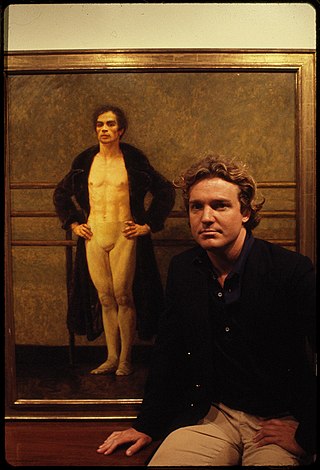
James Browning Wyeth is an American realist painter, son of Andrew Wyeth, and grandson of N.C. Wyeth. He was raised in Chadds Ford Township, Pennsylvania, and is artistic heir to the Brandywine School tradition — painters who worked in the rural Brandywine River area of Delaware and Pennsylvania, portraying its people, animals, and landscape.

Avigdor Arikha was a Romanian-born French–Israeli artist, printmaker and art historian.
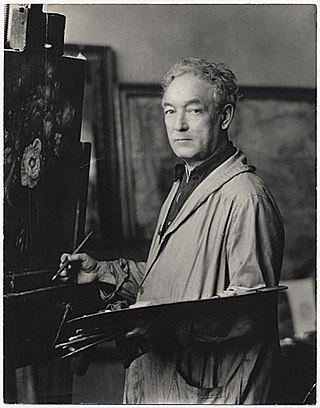
William James Glackens was an American realist painter and one of the founders of the Ashcan School, which rejected the formal boundaries of artistic beauty laid down by the conservative National Academy of Design. He is also known for his work in helping Albert C. Barnes to acquire the European paintings that form the nucleus of the famed Barnes Foundation in Philadelphia. His dark-hued, vibrantly painted street scenes and depictions of daily life in pre-WW I New York and Paris first established his reputation as a major artist. His later work was brighter in tone and showed the strong influence of Renoir. During much of his career as a painter, Glackens also worked as an illustrator for newspapers and magazines in Philadelphia and New York City.

Chaim Goldberg was a Polish-Israeli-American artist, painter, sculptor, and engraver. He is known for being a chronicler of Jewish life in the eastern European Polish villages like the one in his native Kazimierz Dolny in south-eastern Poland. He witnessed the colorful life and began to draw what he saw. The recurring art colony atmosphere became the highpoint of his self-actualization dreams, as he envisioned himself becoming an artist like those who visited the village. He yearned to experience life as they did for himself, and later undertook the mission of being a leading painter of Holocaust-era art, which to the artist was seen as an obligation and art with a sense of profound mission.

Robert Brackman was an American artist and teacher, best known for large figural works, portraits, and still lifes.

Reuven Rubin was a Romanian-born Israeli painter and Israel's first ambassador to Romania.

Rabbi Yaakov Meir Shechter is a prominent rabbi and teacher in the Breslov Hasidic movement in Israel. He is a well-known kabbalist and a rosh yeshiva of both the main Breslov Yeshiva in Meah Shearim, Jerusalem, and the Non-Breslov Shaar Hashamayim Yeshiva in Mekor Baruch. His lectures, both in oral and written form, emphasize the application of Breslov and other related Chassidic and non-Chassidic teachings to the challenges of life and the pursuit of spiritual growth.
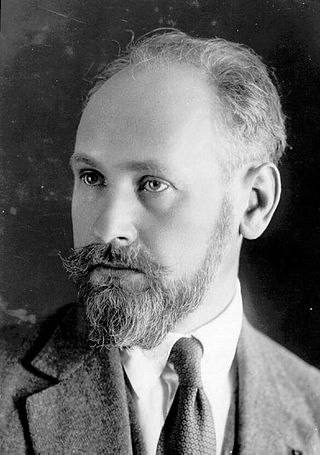
Abel Pann (1883–1963) was a Russian-born Jewish painter and print-maker who settled in the Talpiot neighborhood of Jerusalem in the early twentieth century and taught at the Bezalel Academy of Art under Boris Schatz.
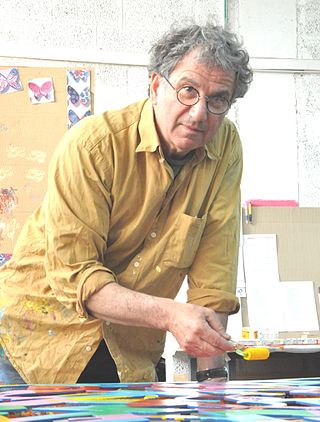
David (Dudu) Gerstein is an Israeli painter, sculptor, draftsman, and printmaker. He began as a figurative painter and was recipient of the Israel Museum Prize for illustration. At the end of the 1970s, he wished to expand the limits of two-dimensional painting, into painting in three dimensions. He began cutting out the main subjects of each painting and, to cancel the background, creating unique and iconic cutout images, free-standing in space, without the standard and traditional square frame.
Elke Reva Sudin is an American painter, illustrator, fashion designer, and lecturer. In 2010, her Hipsters and Hassids painting series premiered in New York City, comparing and contrasting the Hasidic Jewish and hipster Brooklyn cultures. She founded the live sketching company Drawing Booth in 2014, and is also a founder of Jewish Art Now. In 2023, she launched a collection of luxury scarves with her own custom designs.

Jennie Augusta Brownscombe was an American painter, designer, etcher, commercial artist, and illustrator. Brownscombe studied art for years in the United States and in Paris. She was a founding member, student and teacher at the Art Students League of New York. She made genre paintings, including revolutionary and colonial American history, most notably The First Thanksgiving held at Pilgrim Hall in Plymouth, Massachusetts. She sold the reproduction rights to more than 100 paintings, and images of her work have appeared on prints, calendars and greeting cards. Her works are in many public collections and museums. In 1899 she was described by New York World as "one of America's best artists."
Zvi Raphaeli was an Israeli impressionist painter. A rabbi by profession, he merged religion and art deftly in his paintings. He was educated in France from the age of three, and studied art at the École nationale supérieure des Beaux-Arts in Paris, and also at the Bezalel Academy of Art and Design in Jerusalem. He initially studied engineering but after losing many close relatives including his father and brother in World War II, Raphaeli decided to study to be an artist. He was a member of the French Resistance during World War II, and lived in Israel where he moved to, in 1945 at the age of 21. Later on in his life, he also lived in the United States.
Zvi Malnovitzer is an expressionist painter born to a Haredi, or ultra-Orthodox, religious family in Bnei Brak, Israel. His upbringing in a society isolated from the modern world, where he was dedicated to intensive and uninterrupted Talmudic study from a young age, makes his decision to become an artist unusual, bold, and one of accomplishment. During his training in Reichenau, Austria, where he studied under the auspices of artist Wolfgang Manner and under the direction of Ernst Fuchs, Malnvotizer developed a unique style portraying themes that straddle the religious and secular worlds.
Robert Philipp was an American painter influenced by Impressionism and Post-Impressionism, and known for his nudes, still lifes, and portraits of attractive women and Hollywood stars. Noted art critic Henry McBride called Philipp one of America's top six painters of his generation. He was an instructor of painting at the Art Students League of New York for 33 years, the American artist Itshak Holtz was a student of Philipp. Philipp was Secretary of the National Academy of Design, and National Academician, Benjamin Franklin Fellow, Royal Society of Arts in London. He was married to model and fellow artist Rochelle ("Shelly") Post, who frequently posed for him until her death in 1971. His compositions and painting style have been compared to the art of Edgar Degas and Pierre-Auguste Renoir. Philipp won prizes in most of the important exhibitions of his time, and his paintings are in numerous museums and important private collections.

Michael Sgan-Cohen was an Israeli artist, art historian, curator and critic. His oeuvre touches different realms of the Israeli experience and the Hebrew language, displaying a strong connection to the Jewish Scriptures. His works were nurtured by his extensive knowledge of Art history, philosophy, Biblical Texts, Jewish thought and Mysticism, which in turn illuminated all these pursuits. His engagement with Judaism and the Bible as a secular scholar and his vast knowledge of modern and contemporary art contributed to the development of a distinctive approach which combined Jewish and Israeli symbols and images to create a multilayered and contemporary artistic language.
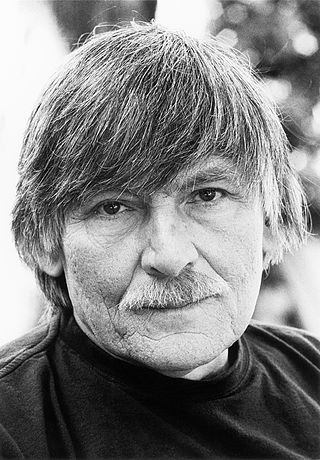
Marek Yanai is an Israeli figurative painter and senior lecturer at Bezalel Academy of Art and Design, Jerusalem. He paints in watercolor and oil. His work as a painter and a teacher has contributed greatly to the establishing and development of figurative expression in art, design and animation in Israel.
Batia Friedkes Grossbard was a Polish-born Israeli painter influenced by American abstract expressionism.
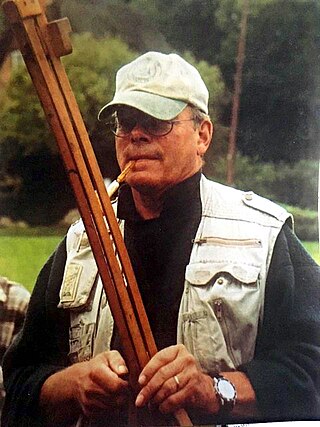
Charles Clark Reid was an American painter, illustrator, and teacher, notable for his watercolor style. He won numerous national and international awards for both his watercolor and oil works, and also hosted many workshops in the US and abroad. He published numerous books and instructional DVDs and created a postage stamp and an iconic ad campaign with his watercolor depictions. His watercolor works and oil paintings are in private and college museum collections.

Moshe Rosenthalis was a Lithuanian-Israeli painter and an art teacher. As a young artist in Lithuania, then part of the Soviet Union, he adapted the dominant Socialist realist discipline. After his immigration to Israel in 1958, where he lived and created for 50 years until his death, he implemented various art methods, including Abstract, Fauvism, Figurative, Expressionism and diverse media and bases. He painted thousands of drawings, portraits, and engravings. His paintings were characterized by vivid colors and Joie de vivre. Many of his works drew inspiration from the Israeli landscapes, images, and peoples, especially of Jaffa Port and Safed.
















